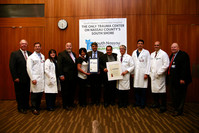South Nassau is certified as trauma center
South Nassau Communities Hospital has been certified as a Level II trauma center by the American College of Surgeons. On July 19 the Emergency Department demonstrated its readiness to handle multiple trauma patients.
The call went out at SNCH: “Trauma team Level One E.R. west code gray lockdown E.R. activate code triage.” The large metal doors to the emergency room flew open, and emergency medical technicians wheeled a “patient,” hypothetically bleeding from multiple gunshot wounds, in from an ambulance.
The hospital’s emergency staff went to work. In a matter of minutes, doctors had assessed his wounds, noted that he was not breathing on one side, inserted a breathing tube, administered blood and other fluids, taken X-rays, stabilized him and sent him to an operating room.
At a conference after the demonstration, Richard Murphy, president of SNCH, explained that, three years ago, the New York State Department of Health had decided not to continue certifying hospitals as trauma centers in the state. The American College of Surgeons, the accrediting body for 40 other states, took over the responsibility for New York hospitals.
South Nassau’s board of directors felt compelled to meet the new challenge, and to be certified as a Level II trauma center. Its board chairman, Joseph Fennessey, said the ramp-up to the new criteria cost about $2 million. “Trauma does not discriminate,” Fennessey said.
In order to meet the new criteria, SNCH must:
Have an in-house surgeon available within 15 minutes, 24 hours a day. In addition, a backup surgeon must be on call in case the in-house surgeon has to care for an emergent trauma case;
Have an operating room available for a trauma patient within 15 minutes;
Recruit surgeons with specialty training in the management and care of the traumatically injured and critically ill, to be both in-house and on call;
Have comprehensive blood product availability;
Have an interventional radiologist on call;
Have a rigorous performance-improvement program to ensure that it is constantly improving its trauma program and the care it provides;
Offer ongoing, trauma-specific education for all trauma team members;
Have an injury-prevention program with a dedicated nurse to identify and implement educational programs to reduce injuries in the community;
Have dedicated, state-of-the-art trauma resuscitation bays in the Emergency Department.
According to the ACS, the standards for providing clinical care to injured patients for Level I and Level II trauma centers are identical. Level I centers must meet admission volume requirements, maintain surgically directed critical-care services, participate in the training of residents, be leaders in education and outreach, and conduct trauma research.
After the conference, supporters presented the hospital with citations commemorating the new trauma designation.

 47.0°,
Fair
47.0°,
Fair 









